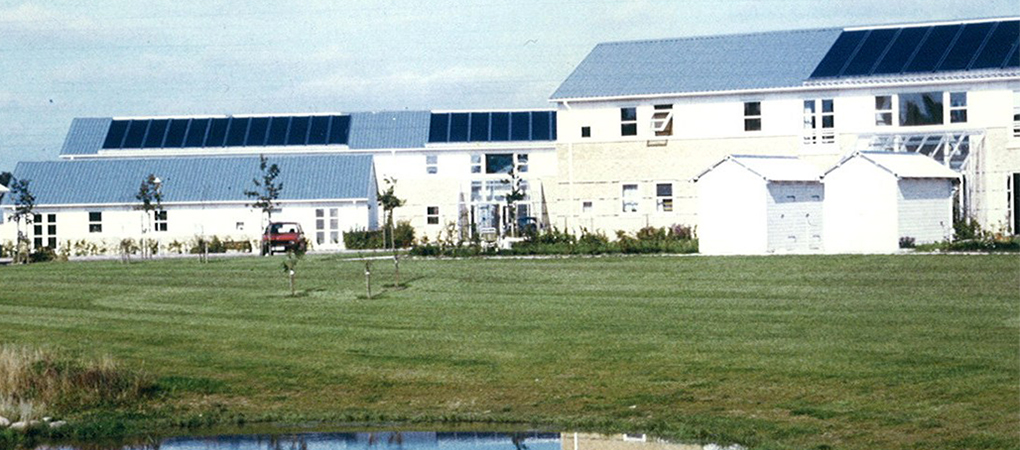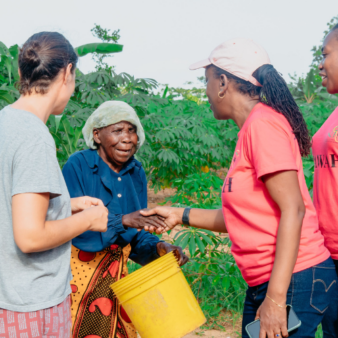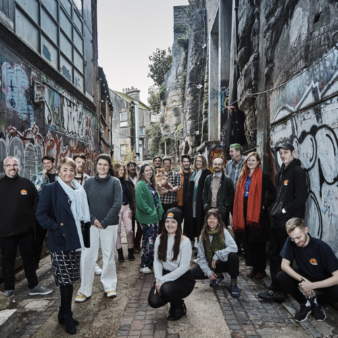The Skotteparken Low-Energy Housing Project of 100 dwellings is an innovative housing project built at Ballerup on the outskirts of Copenhagen in Denmark. Its total energy design aims to significantly reduce energy and water consumption by incorporating a range of energy saving measures, as well as decentralised solar heating systems and a low temperature district heating scheme. Substantial energy and water savings have been achieved and the ideas used here are being replicated and adapted in other projects throughout Denmark.
The Skotteparken Project is one of the latest generation of improvements carried out in Danish housing design over the last 25 years in order to reduce energy consumption. This is an ongoing process and in its turn the experience gained from this project will be further used to refine building design in the future.
The Skotteparken Project was conceived by KAB – a Danish non-profit organisation that manages, advises and builds for social housing organisations and other non-profit organisations in Denmark. KAB is particularly concerned to identify sustainable methods of building and of energy usage for the next century. It has carried out a series of experimental housing programmes in Denmark. Some of these projects, including Skotteparken, are carried out using European Union funding under the THERMIE programme, which funds research into the use of alternative energies.
The Skotteparken Project was designed to overcome problems found in previous solar energy projects where it had been found that the energy gained from a large solar collector field was not commensurate with its cost. Instead of one large solar collector, six individual solar collectors were installed in the Skotteparken project with back-up heat provided by a new combined heat and power installation in a nearby school. The Skotteparken low-energy system was designed to utilise this heat through a series of six smaller buffer tanks situated in the project, which enable heat to be delivered from the large storage tank at the school only as and when the heat levels need to be topped up. This mainly occurs when there is insufficient solar gain to heat them entirely with solar power.
Completed in 1992, the project consists of one hundred terraced houses for rent to low-income households. The dwellings are arranged in six blocks in a horse-shoe shape around a small rainwater lake. As is typical of much new construction in Denmark, the dwellings are built to a high standard using pre-fabricated housing elements. Roofs are made of steel and solar collectors are integrated into the roof construction. A casing or flashing for catching rainwater is placed in front of the solar collectors so that the piping cannot be seen from the street area. In addition to the one hundred dwelling units there is a community room and laundry room for the use of residents. A caretaker is based permanently on the site and deals with routine maintenance of the project. Six small boiler rooms are also included, one in each block. These boiler rooms contain the storage tanks for the domestic hot water system and the computer control system linking it to the mini Combined Heat and Power (CHP) plant at the school.
Most housing estates of any size in Denmark are supplied with district heating. In the greater Copenhagen area a large proportion of the district heating in the public grid is produced in large-scale CHP plants, which use domestic and municipal refuse as one of the main fuels for the production of heat. Experiments are being carried out with mini-scale CHP plants and the Skotteparken scheme is one such experiment. A mini-scale CHP plant consists of a gas engine, a generator, a heat exchanger and a distribution gear in one unit. The CHP plant produces electricity and the surplus heat from the engine is used for heating purposes. Natural gas is used for these small scale plants.
The project is designed to reduce the consumption of gas, water and electricity by 60 per cent, 30 per cent and 20 per cent respectively. The total energy design concept incorporates a range of energy saving features.
The dwellings are arranged in six separate blocks and solar collectors are placed on the roofs of each block. This energy is used to heat the domestic hot water. A total of 5.7 m2 of solar collector is mounted per flat. A highly insulated building envelope ensures that energy requirements are kept to a minimum. High levels of insulation are provided in the walls, roof spaces and under the ground floor to help prevent heat loss. Low-energy windows (U-value 0.95) incorporating low emissivity glass are used to minimise loss of heat. Forced ventilation is necessary in view of the sealed building envelope and heat is recovered from this process by means of a heat exchanger and recycled into the building with an efficiency rate of 80 per cent. Low-energy appliances and lighting have been used wherever possible to reduce the level of energy required.
The heat from the CHP plant is used for the school and is also transmitted to the six boiler rooms in the housing project by means of a low-temperature district heating scheme. An Energy Management System is in operation to monitor controls and flows of energy to ensure optimum use of the energy resources available.
These solar heating systems are used in combination with a low-temperature, pulse operated district heating network. Heat is supplied from a local combined heat and power plant located at the neighbouring primary school.
Conservation of energy in the individual home is primarily based on the extent to which residents can be motivated. Financial incentives and information are important in motivating residents and considerable care has been taken to ensure that residents are aware of the energy saving aspects of the scheme. These have been explained to all residents and guidance is given on how to further reduce their energy requirements. Apartments are individually monitored and charged for energy and water consumption so that there is every incentive to keep usage low.
It is being increasingly recognised throughout Europe that water is becoming a scarce resource and efforts are being made to conserve water. Water saving is a key feature of this scheme, since there is shortage of water in Denmark and charges for its use are high. The kitchens and bathrooms are installed with water saving taps. Rainwater is no longer channelled into the sewers, but rather runs through open gutters into a small lake from where it seeps down into the ground water.
These energy savings have inevitably been achieved at some additional capital and revenue cost. The total pay-back period for the scheme has been calculated to be twenty years, with ten years of this being for the solar heating installation. Analysis has been carried out on the various energy saving methods used and loft insulation has been found to be the most cost effective of the methods. Energy consumption is continually monitored as part of the ongoing research into the operation of the scheme. Rents are slightly higher than other housing projects in the area, although this is more than offset by the savings that accrue to tenants in terms of reduced energy and water bills.
Partnership
NGO, local government, private sector



